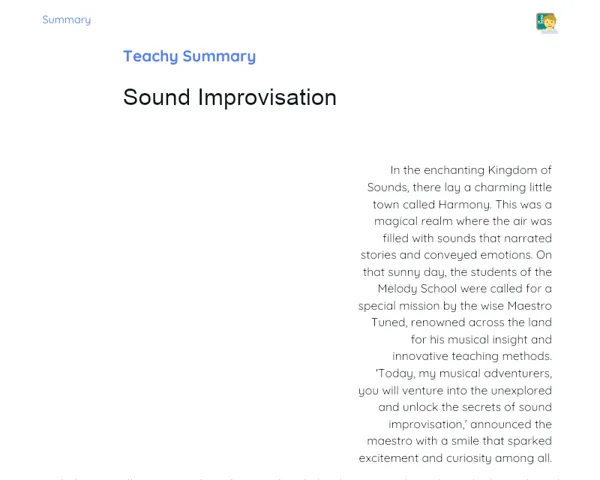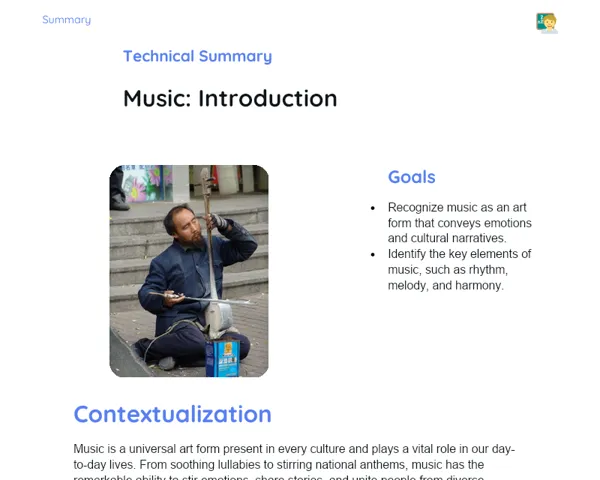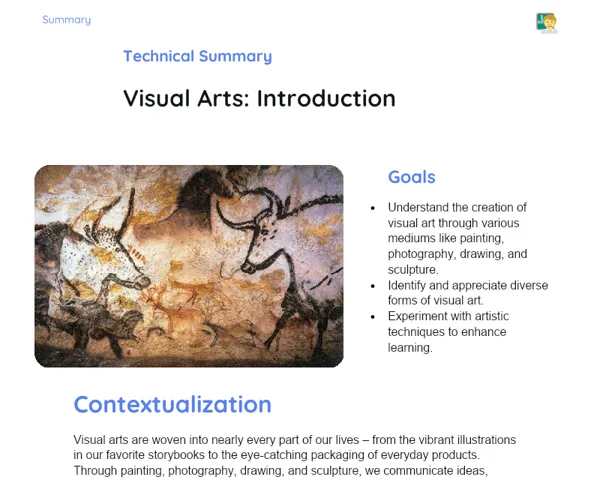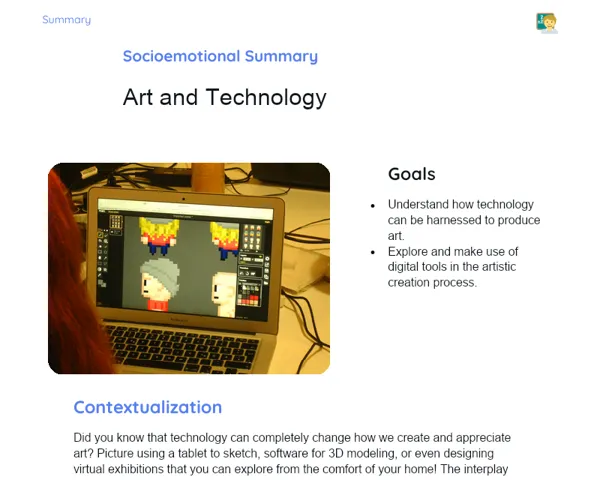Summary Tradisional | Artistic Experiences
Contextualization
Art has always been a fundamental way for people to express themselves, right from ancient times. Children often start drawing and painting early on to express their feelings and make sense of the world around them. Through visual arts, we can share ideas, emotions, and stories while using a mix of techniques and materials. It’s important for first-grade students to be introduced to diverse forms of artistic expression, including drawing, painting, collage, comics, origami, and sculpture.
These different art forms not only spark children's creativity and imagination but also help in developing their fine motor skills, visual perception, and focus. By experimenting with a variety of materials and techniques, students learn to make choices and solve problems creatively. Therefore, art is essential for the holistic development of children, aiding academic, emotional, and social growth.
To Remember!
Drawing
Drawing is one of the oldest and most accessible forms of artistic expression. With simple materials like paper and pencil, even small children can start drawing. Drawing involves using lines, shapes, and shading to create visual representations of objects, people, landscapes, or even abstract ideas. This technique allows for direct expression, making it a significant tool for developing fine motor skills and visual understanding.
Besides being fun, drawing helps children sharpen important skills, like observation and their ability to represent the world around them. As students draw, they pay attention to details and convert their perceptions into visual forms. This exercise is crucial for building both artistic and cognitive skills.
In the classroom, drawing can be integrated into different themes and subjects. For instance, when students draw scenes from stories or study materials, it deepens their understanding of those topics and allows for creative expression. Drawing also provides a platform for each student to experiment, explore, and develop their own unique artistic style.
-
Drawing is a form of artistic expression that uses lines and shapes.
-
Helps develop fine motor skills and visual understanding.
-
Encourages observation and representation of our surroundings.
Painting
Painting is an artistic method that uses colors to create images and express feelings. With paints and brushes, artists can explore a variety of colors and textures, bringing their ideas to life. There are several painting techniques, like watercolor, gouache, and acrylic, each offering its own expressive possibilities. Painting provides more creative freedom, as colors can be mixed and applied in various ways for different visual effects.
For children, painting is a captivating and enjoyable activity. While painting, they get to play around with colors and textures, tapping into their emotions and imaginations. This process not only fuels creativity but also boosts motor coordination and understanding of colors and shapes. Moreover, painting serves as a great way for kids to express their emotions visually.
In an educational setting, painting can be linked to various subjects. For example, by painting scenes from history or natural landscapes, students can deepen their comprehension of these themes. Painting can also be merged into interdisciplinary projects, fusing art with literature, science, and other fields. This supports students in not just honing their artistic skills but also enhancing their holistic learning experience.
-
Painting uses colors to create images and express feelings.
-
Stimulates creativity and fine motor skills.
-
Integrates well with various subjects and school activities.
Collage
Collage is a creative technique where various materials—like paper, cloth, and other objects—are cut and glued onto a surface to create new compositions. This method allows artists great creative freedom, as materials can be mixed in endless ways to create stunning visuals. Collage encourages experimentation and innovation since there are flexible rules regarding material usage.
For children, creating collages is a fantastic way to explore textures, colors, and shapes. As they manipulate different materials, they enhance their fine motor skills and visual perception. Additionally, collage promotes environmental consciousness as kids can reuse recyclable materials. This technique also serves as a medium for personal expression since each collage reflects the unique choices made by the student.
In the classroom, collages can be used to explore diverse themes and concepts. For example, students creating collages on specific subjects can deepen their understanding and express their interpretations visually. Collage can also be integrated into interdisciplinary projects that connect art with history, geography, science, and more. This enriches students’ learning while allowing them to develop artistic skills in a meaningful way.
-
Collage involves using various materials to create a new composition.
-
Promotes exploration of textures, colors, and shapes.
-
Can integrate into various projects and encourages sustainable creativity.
Comics
Comics are a unique type of sequential art that combines images and texts to narrate a story. Each panel in a comic illustrates a scene, while texts, typically found in speech bubbles or narration boxes, add dialogue and descriptions. This combination of visuals and words makes comics a lively form of communication, capable of sharing stories in an engaging and accessible way.
For children, comics are an enjoyable and stimulating medium to delve into reading and writing. By creating their comics, they can hone their narrative skills, experimenting with plots, characters, and dialogues. This process not only ignites creativity but also aids in reading comprehension and storytelling skills. Moreover, comics can serve as a means for personal expression, letting kids share their ideas and experiences in a fun, visual format.
In school, comics can be tied into various subjects and activities. For instance, when students develop comics about historical events or scientific discoveries, they can deepen their understanding of those topics interactively. Comics can also be part of interdisciplinary projects merging art with literature, social sciences, and more areas of knowledge. This approach allows students to enhance both artistic talent and enriching their overall learning experience.
-
Comics blend images and texts to narrate a story.
-
Stimulates creativity and boosts reading comprehension.
-
Can be linked to different subjects and interdisciplinary projects.
Key Terms
-
Artistic Expression: The use of diverse techniques and materials to convey ideas, emotions, and narratives.
-
Drawing: A method that utilizes lines and shapes to create visual representations.
-
Painting: A technique that employs colors and paints to craft images and express emotions.
-
Collage: The art of using assorted materials pasted onto a surface to create a new composition.
-
Comics: A form of sequential art that combines images and texts to narrate a story.
-
Origami: The traditional art of folding paper to make three-dimensional shapes and figures.
-
Sculpture: The technique of creating three-dimensional forms using materials like clay, modeling paste, or recyclable items.
-
Visual Perception: The ability to observe and interpret visual information.
-
Fine Motor Coordination: The skill to perform precise movements with hands and fingers.
-
Sustainable Creativity: The practice of utilizing recyclable materials and eco-friendly methods in artistic creation.
Important Conclusions
In our lesson today, we explored various forms of artistic expression, such as drawing, painting, collage, comics, origami, and sculpture. Each of these techniques presents unique ways of communicating ideas, emotions, and narratives through different materials and methods. Recognizing these art forms is crucial for developing creativity, fine motor skills, and visual perception in children, significantly contributing to their overall growth.
Art enriches academic learning while also nurturing emotional and social skills. By trying out different techniques and materials, students learned to make creative choices and address problems innovatively. Additionally, integrating art with other subjects facilitates deeper, more meaningful learning, effectively linking theory with practice in a dynamic manner.
We encourage students to keep exploring these artistic forms in their everyday lives. Regular engagement in artistic activities can enhance their skills while providing a powerful outlet for personal expression and reflection. Art serves as a valuable tool for understanding and appreciating the world around us, and we hope students continue to explore and cherish this vital area of knowledge.
Study Tips
-
Dedicate regular time to practice different artistic techniques, like drawing, painting, or making collages. Consistent practice improves skills and helps develop a personal style.
-
Visit museums, art galleries, or browse through books and websites about art to learn about various artists and styles. This can inspire new ideas and broaden your understanding of the art world.
-
Consider creating interdisciplinary projects that merge art with subjects like history, literature, or science. This can enrich your learning and provide a comprehensive view of the topics being studied.



